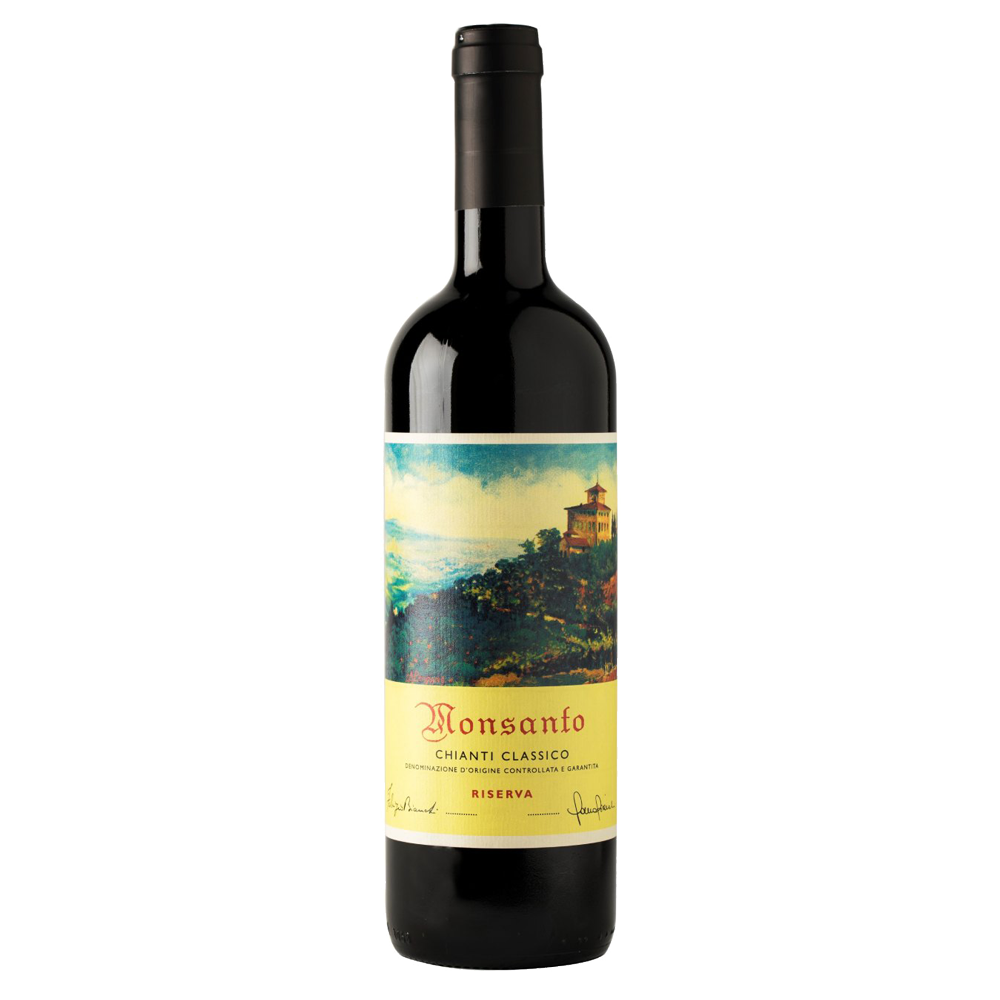The Chianti Classico appellation includes three categories of wine. The first, Chianti Classico, is often referred to formally as Annata, or vintage, and informally as normale. These wines must be aged at least 12 months before they can be sold. Riservas, the second, must be aged at least 24 months, including three months in bottles, before release. The third is Gran Selezione, which must be aged 30 months, including three in bottles, and can only be made from estate-grown fruit, not purchased grapes.
Wines in each category can be top quality, but they differ in the roles they play and in their prices.
Lucky for you, we did the heavy lifting and found an awesome Reserva that’s actually affordable.

Chianti Classico Riserva DOCG
The Wine
Castello di Monsanto
Chianti Classico Riserva DOCG
Estate grown blend of 90% Sangiovese, 10% Canaiolo & Colorino.
Monsanto’s Chianti Classico Riserva reminds us of the Tuscan landscape which is elegantly portrayed on the label: elegant, fecund, positively captivating, timeless, and always in good taste. When one looks across the Arno River from Florence and up into the hills surrounding the city or one gazes over the ramparts of rival Siena, a sophisticated, timeless landscape strikes the eye. Happily, Fabrizio Bianchi has once again captured Tuscany’s alluring countryside in his estate’s picture perfect Monsanto Chianti Classico Riserva. A warm scent of cherries, violets, tobacco, and spice tantalize the nose and set the stage for this sophisticated wine’s ripe, rich flavors and firm, balanced structure. A generous, round mouth feel, layers of flavor and plenty of ripe tannin make for a grateful palate and lend credence to the critic’s claim that some of Tuscany’s most affordable treasures are also Italy’s most enjoyable wines. Breed, grace, and a primal fecundity make this Monsanto Riserva irresistible, but for optimal enjoyment one must have the patience to open this treasure at least an hour ahead. It can also be laid down to mature for another five years or more. Saluté!
The Story
Fabrizio Bianchi is one of Chianti Classico’s greatest innovators and artists. A successful textile manufacturer from Milan, Bianchi purchased Monsanto in 1961 and ever since has been a pioneer in Chianti. He acquired Monsanto with “a consciousness that he was walking on a treasure, not of gold, but mere land.” What Fabrizio has done with that land is turn it into liquid gold in the form of the finest Chianti Classico, and simultaneously transform one of the oldest and most respected wine regions on earth through a series of bold innovations. Monsanto is a large estate by Tuscan standards (206 hectares or a little more than 453 acres), but only a fraction of the total (72 hectares) is actually under vine. Fabrizio and his family have opted to preserve the natural forests of oak, myrtle, and wild berries that surround the estate, thereby protecting the natural pollinators and indigenous yeasts that abound at Monsanto. And from the very beginning, Fabrizio set out upon refurbishing the estate’s vineyards and protecting the special terroir that exists at Monsanto. Consequently, all of Monsanto’s grapes are hand harvested and only the property’s natural yeast is employed in fermentation. Through the years, Fabrizio Bianchi has helped change the face of contemporary Chianti Classico with a series of innovations he instituted at Monsanto. Fabrizio was one of the first to eliminate the white grapes from the Chianti Classico cepage, or blend, in favor of the exclusive use of Chianti’s traditional red varieties: Sangiovese, Canaiolo, and Colorino. He also lobbied for permission to use temperature controlled stainless steel for fermentation, another innovation that is now common place in Tuscany but was unheard of three decades ago. The move to temperature controlled fermentation led Fabrizio Bianchi to take one more pioneering step: the elimination of the governo alla Toscana, an ancient practice whereby whole dried grapes are added to the already fermented Chianti. The result has been cleaner, richer, longer lasting wines that gain both grace and complexity with age. Nearly all quality Chianti producers have followed Bianchi’s lead. In addition to revitalizing Chianti Classico, Monsanto has been at the vanguard of Tuscany’s renewed interest in traditional French varietals such as Chardonnay and Cabernet Sauvignon, which the Bianchis also fashion into award winning wines. Furthermore, Monsanto produces a small quantity of a single cru 100% Sangiovese that is labeled Sangioveto Grosso from their Scanni vineyard and a bit of Vin Santo from Malvasia and Trebbiano.
Here’s The Offer
Regular Price on this beauty….$32
Our Price For you…$26

